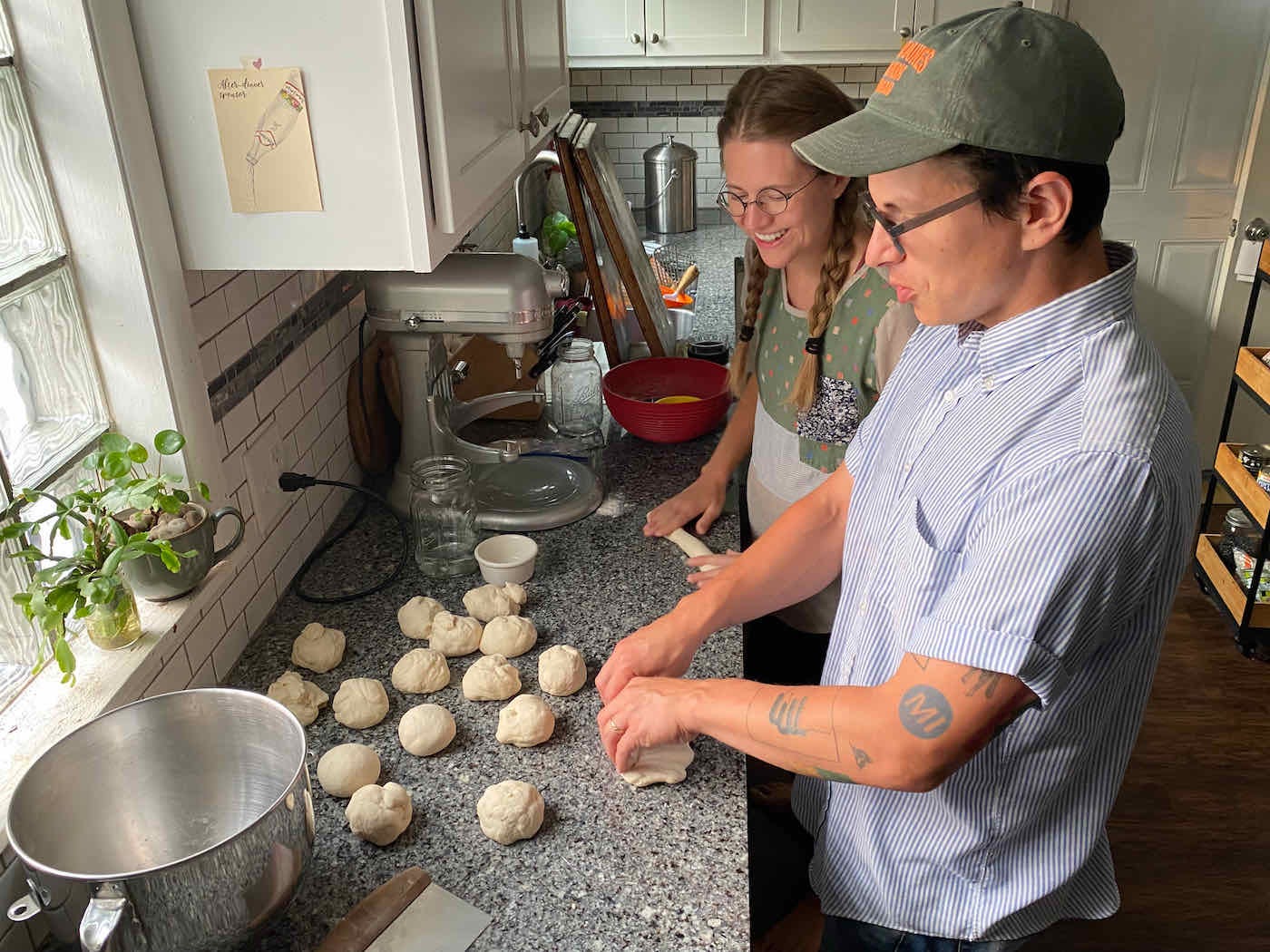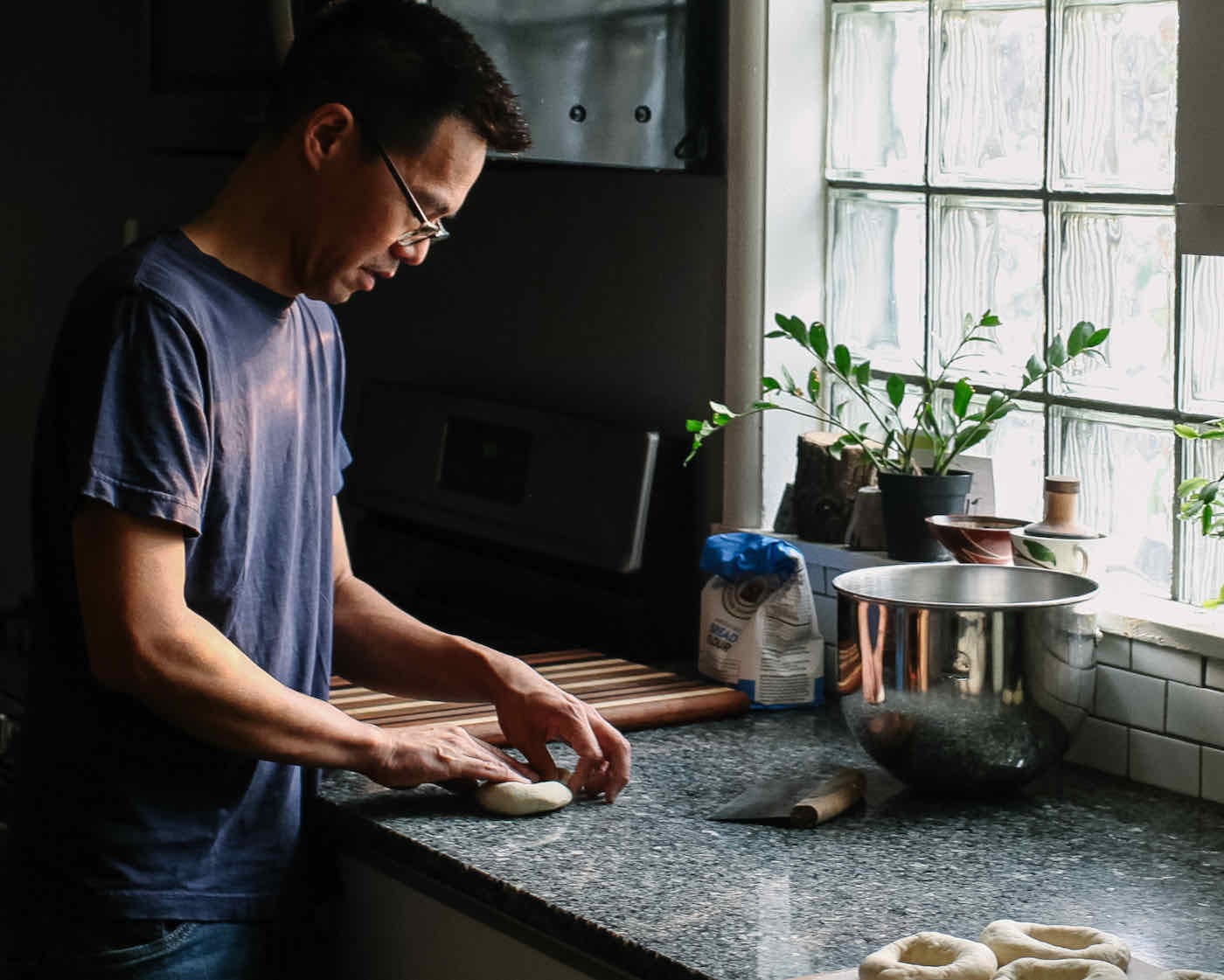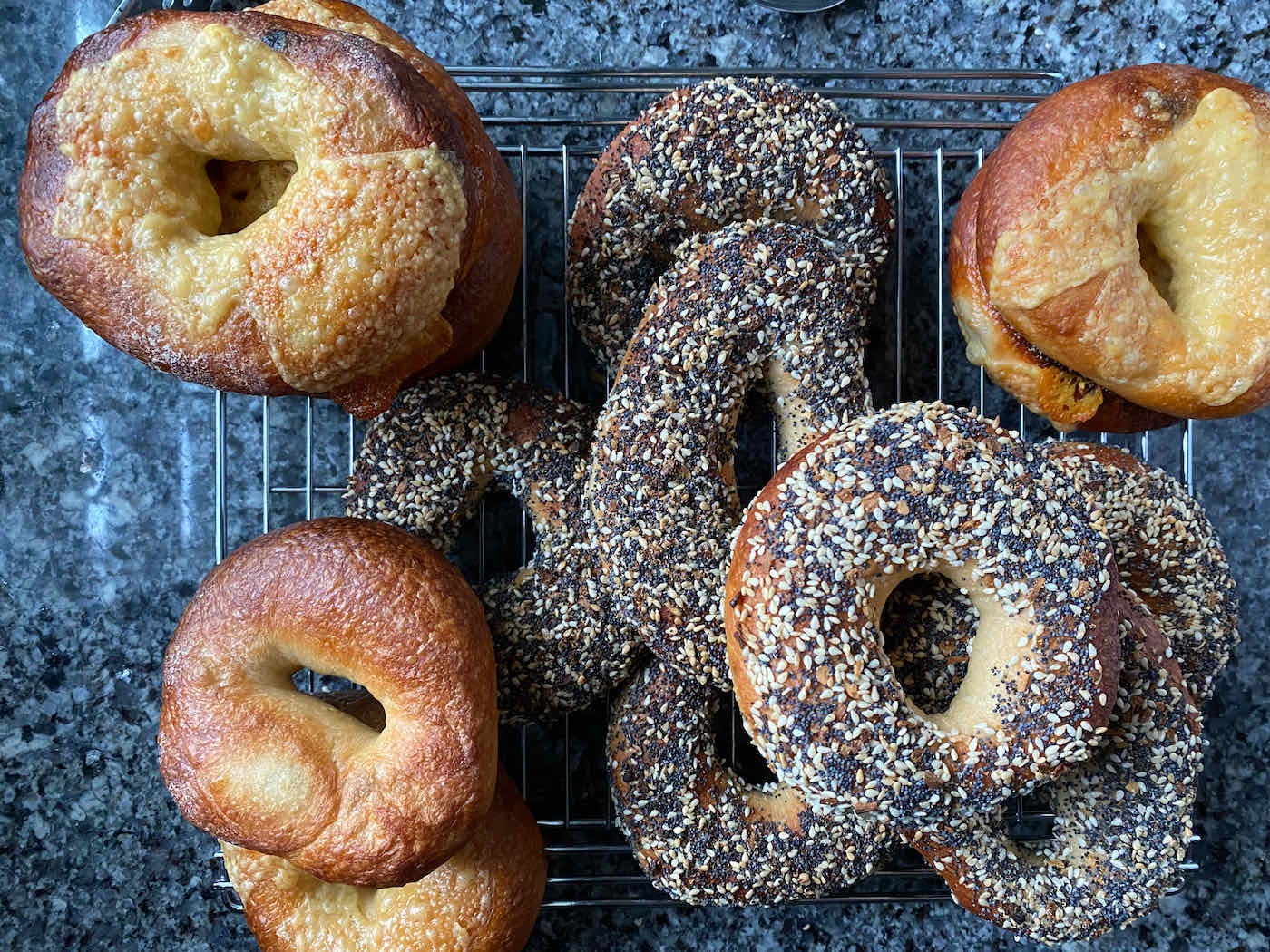Psalms and Bagels
Some fragmented thoughts on ancient songs and prayers, a bagel-making lesson, and the flowers of the field
Saturday, August 28
Chattanooga, Tennessee
Hi, kind reader.
I’m a little late with my letter to you this week. We’ve had a lot going on at our house, and now I’m on a quick trip to Tennessee to cook some Chinese food for friends. (Especially if you’re traveling, for the love of yourself and for your neighbor, please mask up and stay safe.)
I’m convinced more than ever that the Book of Psalms was given to us for nearly every circumstance in life—a prayer book for the ages. Last Sunday, I preached on Psalm 22. Many of us know a bit of this psalm because Jesus quotes from it—“My God, my God, why have you forsaken me?”. It feels as if it’s a psalm for this moment—until it doesn’t. I almost got annoyed at how it turns repeatedly toward possibility and hope, when sometimes I’d really rather sit in my disappointment and sadness. But it’s precisely because of its insistence on hope that I think it’s so valuable.
Much of the hope comes from the psalmist’s repeated turns beyond himself. He makes a bold claim on God—my God, the psalm begins. He turns to his ancestors and remembers their testimonies. He turns to his birth and his realization that, in his most vulnerable moment of life, at the very beginning of his days, he relied on a woman for nourishment and on his God for existence. He turns to others, and where he calls on his siblings to praise God, I wonder if it’s because he might be struggling to do it himself. Yet through their shared outcry, there can be both solace and strength.
After Sunday’s (online-only) service, a few of us gathered in a Zoom room to catch up and share; people spoke of their worries about COVID and the new school year as well as fears for the safety of friends in Afghanistan. Then, scrolling through my social-media feeds, I notice so many expressions of anger and discord, so many feelings of abandonment and despair.
Thoughts and prayers can feel empty and hollow, except, I guess, if you have little else. Thoughts and prayers can seem senseless and even callous, unless they offer some steadying ground for a shaky spirit and stability for a tender soul. Maybe thoughts and prayers can urge us onto the next thought—how might I show up concretely for a friend or a neighbor?—and the next prayer. As Simone Weil wrote, “Attention, taken to its highest degree, is the same thing as prayer.” When I remember that line, I’m reminded that prayer can and should move us and compel us into loving action.
This is a prayer I wrote last weekend, after Psalm 22, as I sat with the testimonies and the tears of people in my congregation. Turning over these words and lines has been helpful to me, and I hope there’s something in there that will be helpful to you.
After Psalm 22
My God, my God, why have you forsaken us?
Why have you left us with our own expertise?
Why have you abandoned us to our own search results?
Why have you given us over to Twitter and Facebook?
Tell us again the stories of our ancestors
Whom you accompanied, whom you delivered,
To whom you gave wisdom, to whom you granted solace,
Who trusted in you, who cried out to you,
To whom you were faithful, to whom you showed your steadfast love.
My God, my God, where are you?
Show yourself to us—and then once more.
Save us from the chatterers’ mouths and the keyboard warriors’ clatter,
Deliver us from the inaction of the comfortable and the injustice of the idle.
We are weary with grief, exhausted by suffering,
Parched by cynicism, hungry for hope.
My God, my God, draw near to us
And remind us once more
That we can learn from our mistakes,
That humility is embodied wisdom,
That tenderness is not weakness,
That “freedom for” is more powerful than “freedom from,”
That openheartedness is strength,
That belovedness can be our balm,
That you are here.
My God, my God, tell us again that we belong
To you, to each other, and to the great congregation.
Sing us another song of your embrace,
And summon us into the chorus of the great congregation—
With the sun and the moon and the stars,
With the mountains and the sea,
With the oak and the maple, the zinnia and the milkweed,
With the warbler and the robin, the owl and the hawk,
With the neighbor we like and the one we don’t,
With the refugee and the immigrant,
With the vulnerable and the lonely,
With the survivor and the seeker,
We will praise you, with our children and our children’s children,
For you have been our salvation and you will be our rescue again.
What I’m Cooking: As a kid, I rarely had a good bagel; we had adequate bagels, and that was enough. My mom always kept a stash of Lender’s mini-bagels in the freezer, and we’d pop them into the toaster, then slather them with cream cheese. It wasn’t until adulthood until I had an excellent bagel, from H&H, in Manhattan. Crisp on the outside, chewy within, shedding everything topping all over, well, everything. Always toasted. Cream cheese is good. Bacon, egg, and cheese? Even better. With layers of smoked salmon—that makes for a special occasion.
After we moved to Grand Rapids, friends in New York heard my longing for good bagels and shipped some to us. Then, some months ago, Angela Palumbo Ochoa, who, with her husband, Tony Ochoa, has a small, home-baking operation called the Cottage Bagel reached out to suggest that maybe I might be able to find a good bagel in Grand Rapids, because she and Tony make them.
Naturally, I was skeptical, but I also live in hope. So I stopped by the Ochoas’ home early one morning to pick up some freshly baked bagels and brought them home to Tristan. We toasted them, carefully applied cream cheese, and tasted. Tristan looked at me after a couple of bites. “These are really good,” he said. And he was right. They were really, really good.
The Ochoas’ bagels are smaller than you’d typically find in New York City, the holes are larger, and they contain a bit of sugar, which Montreal bagels do but New York ones usually do not. It’s almost as if a New York bagel and one from Montreal produced offspring. They bake them pretty dark and crisp on the outside, but they retain the pleasing chewy density on the inside. As I said, they were really, really good.
Last month, I asked Angela and Tony whether they might be willing to give me a bagel-making lesson. Angela asked me to show up at their house on a Monday morning at 6 a.m., which I agreed to, even as I thought this might be the rapid end of my bagel-making adventures. Turns out this was more about convenience—it would give us time to bake, have a cup of coffee, and talk in the quiet before their kids got up—than about a doctrinally proper time to make a bagel. But it’s also the right timing if you want fresh-baked bagels for breakfast two days hence.
Angela’s earliest bagel memories are of “soft, bready, blueberry bagels—and I liked cream cheese, so I liked bagels.” They first had a New York bagel nearly a decade ago, at Tompkins Square Bagels, in the East Village. “I remember parts of the experience, but I didn’t know what I should be getting out of it,” she told me. Back in Grand Rapids, they found GR Bagel, which had sold hand-rolled, boiled-then-baked bagels at the Fulton Street Farmers’ Market before opening a proper bagel shop in 2012. (GR Bagel has since closed.) “The had to introduce to Grand Rapids what a boiled bagel was and meant,” Angela said. “That’s how we realized there was a right way to make a bagel.”
Tony likes to make things—and not just make things, but also obsess about how to make them just so. For Christmas 2014, amidst a season of financial austerity, Angela gave Tony the ingredients to make homemade bagels. Those first ones were just okay. “They were all pretty flat,” Tony recalled. The main issue wasn’t the flavor so much as everything else. “Crust. Sheen. Texture. I was concerned about the structure.” Mediocrity aside, a realization thrilled him: “I’d never considered that if I baked my own bagels, I could eat as many as I want with little remorse,” he said. “For me, it was joy. But I was easily enthralled.”
The following year, the Ochoas moved to the Republic of Georgia for work, which gave them an opportunity to keep making bagels—a taste of home and also something to do. “The carb scene in Georgia is plentiful and wonderful,” Angela said. “But they did not have good bagels.” Sometimes Tony would make his own dough. But they also happened to live upstairs from a bakery, so sometimes Tony would buy their neighbor’s dough and shape them into bagels.
They continued their experimentation after moving back to the U.S. in 2017, testing and tinkering, watching YouTube videos and reading about proofing and learning about fermentation and trying different flours. Their emphases were slightly different in this time of trial and error. Tony told me that he is more rigid in his fidelity to recipes and processes (he grew up Reformed). Angela, on the other hand—“she wants to feel the dough” (she grew up Pentecostal). For Tony, getting the proofing right was key. “The right bubbling and texture—the only way we’ve been able to achieve that is to do a long ferment in a refrigerated space,” he said. For Angela, rolling has been crucial to achieving bagel perfection. “Many recipes online tell you to make a round and poke a hole through, but rolling the dough helps develop the gluten—and it’s a lot more fun,” she said. “I’m still trying to get better at it.”
As we made bagels in their kitchen on that Monday, the early-morning light filtering through the window, I came to understand that a bagel is its own little ecosystem— yeast at play with flour and water—and it also responds to the ecosystem around it. The morning was warm. “The last three weeks, our bagels have been 25 to 50 percent shorter, because the yeast has been overactive, because it has been hot and humid,” Tony said.
We popped our rolled and shaped bagels into the fridge to proof—for two days. When I returned on Wednesday, again at 6 a.m., we continued with boiling, seasoning, and baking. As we went through the various steps, Angela explained to me that bagel-making has taught her a new kind of attentiveness. “A loaf of bread is wonderful—nothing bad on bread. But an individual bagel is held so many times. To me, that’s part of what makes it special,” she said. “And then there’s the eating: Bagels are slow to eat—slower than a slice of bread.” A bagel has density and chewiness that asks subtly for effort, for engagement. A bagel is a summons to attention in a way that a pillowy shokupan loaf or a buttery Parker House roll, delightful as they might be, does not.
Angela thinks too about the history of the bagel, which is a distinct storyline in the broader history of bread. “This is a food rooted in culture and history. To experience something with your hands and to engage with so many of your senses as people have been doing for hundreds of years—it connects me to the history of bread, and that’s really special,” she said. “It’s like if you use butter and eat cheese—milking a cow, just once in your life, it changes your experience of that.” (For more on the history of the bagel, its cross-cultural connections, and its particular significance in the story of Poland’s Jewish community, read The Bagel: The Surprising History of a Modest Bread, by the journalist Maria Balinska.)
As we talked, we boiled batch after small batch of bagel, then dipped them in shallow bowls of everything seasoning. Angela says that Aldi sells an impressive everything, but they always make their own; she’s not sure if the minced garlic and onion in the store-bought mix is pre-toasted and worries that it might burn if it is. Then we put the pans of bagels into a hot oven, then turned them, then extracted them, then plopped the hot bagels onto cooling racks.
Tony has developed a ritual around the eating of a bagel, but it’s a halcyon moment that can’t be forced and that, with a house full of young children, can’t always be summoned. The key ingredients, beyond quiet: good coffee, a bagel, and a book—“always fiction,” he said. “My favorite is zombie apocalypse.” He sits in a corner, sipping and munching and reading. “It’s the essence of contentment. It’s the fruit of our labor of brewing coffee, baking a bagel, and cultivating a safe and restful place.”
Later, I thought about Tony’s curation of a bagel-consuming experience. Of course it’s a simple pleasure just to scarf down a bagel toasted with cream cheese. But it somehow also honors this baked creation to savor it more slowly and to contextualize in a ritual that honors deliberation and extended enjoyment. After all, you can’t rush the bagel-making process, so why speed through the act of consuming it?
Angela and Tony’s recipe for bagels appears at the end of this letter. You can also follow their bagel-making adventures—and, if you’re in Grand Rapids, order their bagels—via Instagram at @thecottagebagel.
What I’m Growing: I’m too embarrassed to post a picture of the weedy mess that my community-garden plots have become. Amidst it all, though, things still bloom. Last week, I put together a bouquet for friends—sunflowers, zinnia, celosia, one or two sad snapdragons, some basil blossoms. One delight was finding things I hadn’t planted for flower purposes but sprang up anyway. There was the volunteer amaranth that rose up amid my tomatoes. In the yard, we have some robust Canadian goldenrod in bloom as well as hydrangea and too much mint. And my broccoli rabe is bolting, which isn’t great for the leaves but means that we have pretty little yellow flowers.
There is so much grief in the headlines right now—and there is so much sorrow that will never make the news. I was reminded of this on Thursday as I talked with a friend who has poured herself into helping organizing evacuations from Afghanistan over the past couple of weeks. What we glimpse in the newspapers and online is but a fraction of the story. There is so much we don’t know and can’t know. And the invitation I hear again in all this is to hold with compassion those we encounter. Let’s be gentle with one another and with ourselves.
If there’s anything I can be holding in prayer for you this week, please leave a comment or send me an email (makebelievefarmer@gmail.com). And as always, I love hearing what you’ve read might be stirring up in you.
I’m so grateful we can stumble through all this together. I’ll try to write again soon.
Yours,
Jeff
10 Cottage Bagels
Angela and Tony Ochoa
400-425 g water*
9 g active dry yeast**
45 g sugar
100 g pre-ferment (optional)
750 g unbleached bread flour (we use King Arthur at home)
30 g kosher salt
Semolina flour (optional)
Toppings (seeds, cheese***, flaky salt, etc.)
For boiling:
1 T turbinado sugar or molasses or brown sugar
½ t baking soda
Tony’s Everything Seasoning
2 T sesame seeds
2 T poppy seeds
1 t kosher salt
1 t dried minced or granulated garlic
1 t dried minced onion
Equipment we use (much of which can be substituted!)
KitchenAid stand mixer with dough hook
Dough cutter
Pans/baking sheets or board for proofing (you probably won’t fit them all on one)
Pans/baking sheets for baking
1 standard large pot
Skimmer
Parchment paper
2 cooling racks
Timer
*Water depends on humidity. Dough should be on the dry/tough side. Begin with less water and add a bit more later if necessary.
**If doubling recipe, increase yeast to 14 g rather than 18.
***We love Kerrygold’s Dubliner cheese. Anything that’s not too moist will work!
Day 1
1. MIX: Add to mixer with dough hook in order: water, yeast, sugar, pre-ferment (if using), flour, salt. Mix on lowest speed—this is important, because the density of the dough has been known to break fragile mixers—for 8 minutes. Then, do the window pane test if it makes you feel better.
2. DIVIDE: Give the dough a pat and tell it that it looks good. Use a dough cutter or tear the dough into pieces around 135 grams each. Save remaining dough and refrigerate for future pre-ferment—or make an adorable baby bagel.
3. SHAPE: Dust a pan or board with some semolina flour; alternatively, use parchment paper or a silpat. Take one divided dough piece. Using your palm, flatten the dough into a rectangle/oval shape. Starting from the top, roll tightly towards you and press, eliminate air pockets, forming a snake shape roughly 10 inches long. Grab one end of the snake and wrap it around your hand, twisting it once, grabbing the loose end with an inch overlap. Keeping it wrapped around your hand, press overlapped ends on counter and roll back and forth to seal.
Helpful videos for this confusing explanation:
Diana Daoheung
Claire Saffitz
Note: your shaped bagels will look lumpy at this point. Fear not! Time in the fridge will smooth everything over, no matter what Claire tells you!
4. PROOF: Place shaped bagels on prepared pan/board, leaving a little room in between each. Keep shaped bagels at room temp for about 20 minutes. Then place the entire board into a clean trash bag or cover in plastic wrap. Place them in the refrigerator to rise undisturbed for 48 hours.
Day 2
Think about your bagels all day long. Double check that you have enough cream cheese on hand.
Day 3
1. PREP: Set oven to 500 degrees F. Fill a large pot 3/4 with water and bring to a boil on high heat. Get a new pan with parchment paper ready. Set one cooling rack near the pot of boiling water; this is where boiled bagels will go before baked. If you’re making everything bagels, make your seasoning; if you’re making everything, sesame, or poppy-seed bagels, pour those toppings into shallow bowls. If you’re making cheese bagels, slice your cheese.
2. FLOAT TEST: Fill a small bowl with room-temperature water. Drop one bagel in the bowl to check if it floats. If it does not, pull the bagel tray from fridge to finish proofing at room temperature. Repeat float test with a new bagel every 10 mins.
3. BOIL: When water is boiling, add turbinado sugar and baking soda. The proofed bagels are hardly fragile at this point; you can work with them quickly, but do not pull on their shape. Add as many bagels to the pot that comfortably fit—maybe four. Set timer for 1½ minutes. After 1½ minutes on the first side, flip bagels and boil for another 1½ minutes on their opposite side. After boiling each bagel for a total of 3 minutes, remove with a skimmer and plop on the cooling rack. Repeat the process until all bagels are boiled.
4. SEASON: While the next bagels are boiling, season first group of bagels.
For salt bagels: Sprinkle salt of choice (not table salt! Flaky sea salt works) on pan where salt bagels will go. Add desired bagels to pan and sprinkle more salt generously on top.
For everything, sesame, or poppy-seed bagels: Dunk wet bagels in seed bowls. Flip and dunk the other side.
For cheese bagels: Add plain bagels to pan. You won’t top the bagels with cheese until halfway through baking.
5. BAKE: Bake bagels for 8 minutes. Then rotate the pan(s). If you’re making cheese bagels, now is the time to add some cheese on top of those bagels. Bake 8-10 more minutes, or until golden with a hard crust. Our bagels usually bake for a total of 16-25 minutes. Remove bagels from pans immediately and place on a cooling rack or cutting board.
6. EAT: Wait 30 minutes before slicing…. Or at LEAST 10 minutes if you’re very excited.
Notes from Angela:
There are multiple methods for making great bagels. After years of trials, this is the route we have settled on, though I expect it will continue to evolve. The videos shared above in Day 1 Step 3 from Diana and Claire (my bagel heroes) are excellent tutorials providing varying stages of proofing, shaping, etc.
Our use of raw sugar instead of malt syrup is purposeful. We’ve adapted the recipe to only include what’s readily accessible to us here in Michigan.
I just don’t question the “New York water” thing.
I haven’t been to the brilliant NYC in 10 years, but the next time I am there (which I hope will be soon), these are the first 3 places I am RUNNING to in this order:
Black Seed Bagels
Chama Mama
Russ and Daughters








Psalm 22 is one of my favorites. Reading about the Ochoas was a fun bonus-Tony and one of my daughters went to school together :-)
Thank you for the beautiful prayer. I live in a state where the majority don't believe in science; thankfully, my school district is wise and is requiring masks. I started my 29th year of teaching 9th graders two weeks ago and am exhausted and scared and fragile. My step-dad died a month ago and I am trying to help my mom navigate that while homebound because of a fall she took. My oldest went back to his senior year at Oklahoma and my middle son leaves in a couple of weeks for Southern Oregon. I am feeling all the feels without yet shedding tears. I could take any prayers you could offer.